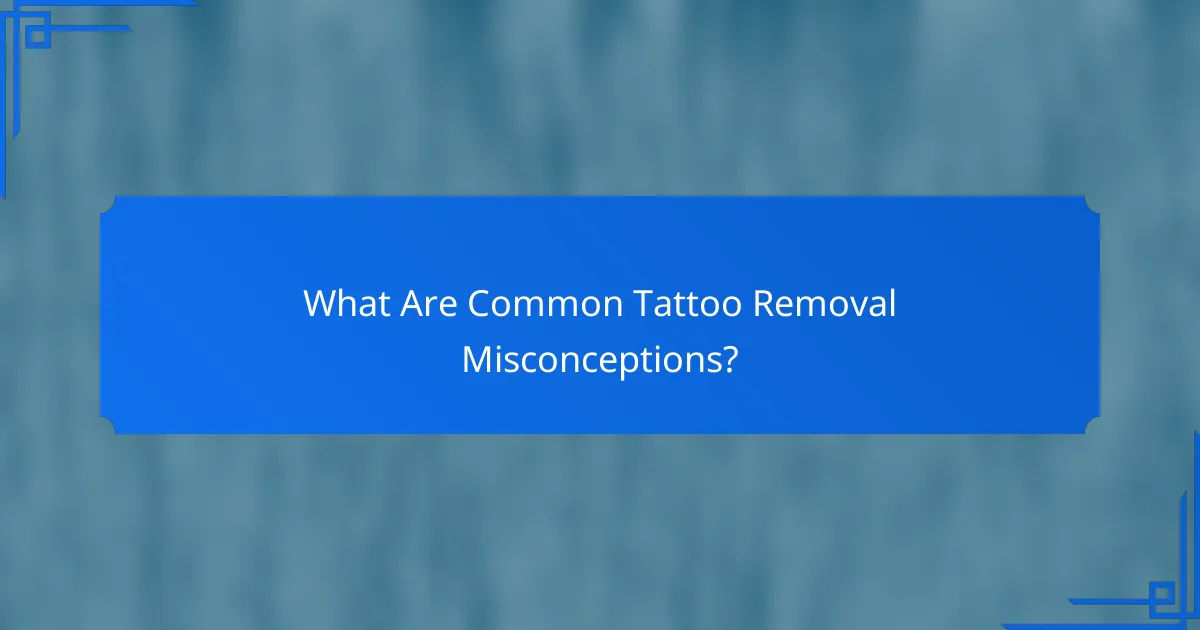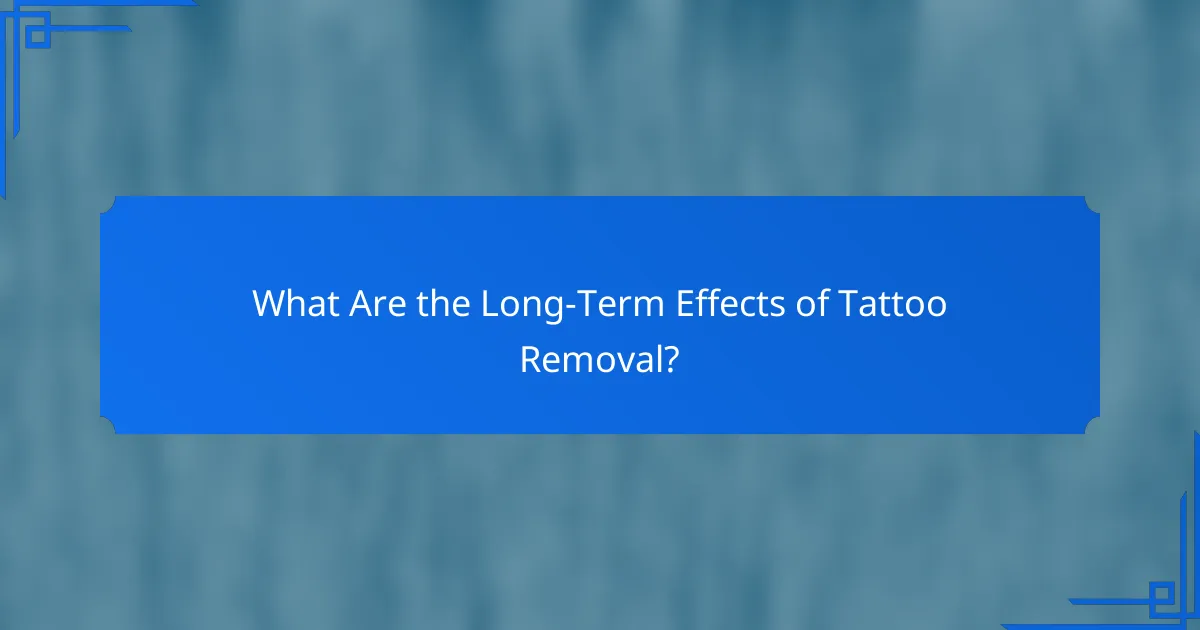Tattoo removal is often surrounded by misconceptions, especially concerning pain, effectiveness, and safety. While laser treatments are the most common and can be quite effective, the success of removal depends on various factors such as the tattoo’s age and ink type. Additionally, the pain experienced during the process can vary significantly based on the removal method and individual tolerance.

What Are Common Tattoo Removal Misconceptions?
Many people hold misconceptions about tattoo removal, particularly regarding pain, effectiveness, and safety. Understanding these misconceptions can help individuals make informed decisions about the removal process.
Pain Levels During Tattoo Removal
Pain levels during tattoo removal can vary significantly depending on the method used and individual pain tolerance. Many report that laser removal feels similar to a rubber band snapping against the skin, while others may experience more discomfort.
Topical anesthetics are often applied to minimize pain, and some clinics offer additional pain management options. It’s essential to discuss pain expectations with your provider before starting the removal process.
Effectiveness of Different Methods
The effectiveness of tattoo removal methods can differ widely. Laser removal is generally considered the most effective, often requiring multiple sessions to achieve satisfactory results. Other methods, such as dermabrasion or chemical peels, may not be as reliable and can lead to scarring.
Factors such as tattoo age, ink colors, and skin type can influence how well a method works. Consulting with a professional can help determine the best approach for your specific tattoo.
Safety Concerns with Tattoo Removal
Safety is a crucial consideration in tattoo removal. While most methods are generally safe when performed by qualified professionals, there are risks such as skin irritation, scarring, and infection. Ensuring that the procedure is done in a sterile environment is vital.
It’s also important to follow aftercare instructions carefully to minimize complications. Researching the provider’s credentials and reviews can help ensure a safer experience during the removal process.

How Effective Is Tattoo Removal?
Tattoo removal can be quite effective, particularly with laser treatments, which are the most common method. However, the success of removal varies based on factors like tattoo age, ink type, and skin type.
Success Rates of Laser Removal
Laser removal typically boasts success rates of around 70-90% for complete tattoo removal after multiple sessions. Factors influencing these rates include the color of the ink, the depth of the tattoo, and the individual’s skin type.
Light-colored inks, such as greens and yellows, can be more challenging to remove than darker colors like black or blue. Generally, treatments are spaced several weeks apart to allow the skin to heal and the body to eliminate the ink particles.
Alternative Methods and Their Effectiveness
Alternative methods for tattoo removal include dermabrasion, chemical peels, and surgical excision. While these methods can be effective, they often come with higher risks of scarring and may not achieve the same level of completeness as laser treatments.
For example, dermabrasion involves sanding down the skin, which can be painful and may require significant recovery time. Chemical peels use acids to remove the outer layers of skin, but results can vary widely. Surgical excision is typically reserved for smaller tattoos and involves cutting out the tattooed skin.

What Are the Pain Factors in Tattoo Removal?
The pain factors in tattoo removal vary significantly based on the method used, the individual’s pain tolerance, and the size and location of the tattoo. Common methods include laser removal, surgical excision, and dermabrasion, each presenting different levels of discomfort and recovery experiences.
Comparison of Pain Levels by Method
Laser tattoo removal is often described as feeling like a rubber band snapping against the skin, with pain levels typically rated from mild to moderate. Surgical excision, while effective for smaller tattoos, can involve more significant discomfort and a longer recovery period due to the invasive nature of the procedure. Dermabrasion may cause a burning sensation and is generally considered to be painful, often requiring local anesthesia.
In general, pain levels can be subjective; however, many patients report that laser removal is the least painful option when compared to the other methods. It’s advisable to consult with a professional to discuss pain management options, such as topical anesthetics or sedation, which can help minimize discomfort during the procedure.
Patient Experiences and Testimonials
Many patients share their experiences regarding pain during tattoo removal, highlighting that individual pain tolerance plays a significant role. Some report that the initial sessions of laser removal are more uncomfortable, while subsequent sessions tend to be easier as the skin becomes accustomed to the process.
Testimonials often emphasize the importance of choosing a skilled practitioner. Patients who felt well-informed and supported during their treatment reported lower anxiety levels, which can contribute to a more manageable pain experience. Engaging in discussions about pain expectations and management strategies with the provider can enhance comfort throughout the removal process.

What Safety Measures Should Be Considered?
When considering tattoo removal, safety measures are crucial to ensure effective and risk-free procedures. Key factors include understanding regulatory standards, choosing a qualified practitioner, and being aware of potential side effects.
Regulatory Standards for Tattoo Removal
Regulatory standards for tattoo removal vary by country and region, often focusing on the safety and efficacy of the devices used. In the United States, for example, the FDA oversees the approval of laser devices, ensuring they meet specific safety criteria. Familiarizing yourself with local regulations can help you choose a compliant facility.
In Europe, the CE marking indicates that a product meets safety standards, which can apply to tattoo removal equipment. Always check if the clinic follows these regulations to minimize risks associated with the procedure.
Choosing a Qualified Practitioner
Selecting a qualified practitioner is essential for safe tattoo removal. Look for professionals who are licensed and have experience with the specific removal method you plan to use, such as laser treatments. Checking reviews and asking for before-and-after photos can provide insight into their expertise.
It’s advisable to schedule a consultation to discuss your specific needs and any concerns you may have. During this meeting, inquire about their training, certifications, and the safety measures they implement in their practice to ensure a safe experience.

How to Choose the Right Tattoo Removal Method?
Choosing the right tattoo removal method depends on various factors, including the tattoo’s size, color, and location, as well as your skin type and pain tolerance. Understanding the available options and their effectiveness can help you make an informed decision.
Factors Influencing Method Selection
Several factors play a crucial role in selecting a tattoo removal method. The type of ink used in the tattoo, the depth of the ink in the skin, and the age of the tattoo can significantly affect the removal process. For instance, older tattoos may fade more easily than newer ones, while certain colors, like green and blue, can be more challenging to remove.
Additionally, your skin type and sensitivity should be considered. Some methods may cause more discomfort for individuals with sensitive skin. It’s essential to weigh the pros and cons of each method, such as laser removal, surgical excision, or chemical peels, to determine which aligns best with your needs.
Consultation Recommendations
It’s advisable to seek out practitioners who are certified and experienced in tattoo removal. Look for reviews or testimonials from previous clients to gauge their satisfaction. A thorough consultation will ensure that you are well-informed and comfortable with your chosen method, ultimately leading to a more successful outcome.

What Are the Costs Associated with Tattoo Removal?
The costs of tattoo removal can vary significantly based on the method used, the size of the tattoo, and the number of sessions required. Generally, laser removal is the most common and effective method, but it can be costly, often requiring multiple treatments for optimal results.
Average Pricing for Laser Removal
Laser tattoo removal typically ranges from several hundred to a few thousand dollars, depending on factors such as the tattoo’s size, color, and location on the body. On average, each session can cost between 200 and 500 USD, with larger or more complex tattoos requiring more sessions, sometimes up to ten or more.
Many clinics offer package deals that can reduce the overall cost per session. It’s advisable to consult with a professional to get a personalized estimate based on your specific tattoo.
Cost Comparisons with Other Methods
Other tattoo removal methods, such as surgical excision or dermabrasion, can have different cost structures. Surgical excision may range from 1,000 to 3,000 USD, depending on the tattoo’s size and the complexity of the procedure.
While methods like chemical peels may appear cheaper, they often require multiple treatments and may not be as effective as laser removal. It’s essential to weigh the costs against the effectiveness and potential risks of each method before making a decision.

What Are the Long-Term Effects of Tattoo Removal?
The long-term effects of tattoo removal can vary based on the method used, skin type, and aftercare. Generally, most individuals experience minimal long-term issues, but some may face challenges such as skin texture changes or discoloration.
Skin Health Post-Removal
After tattoo removal, skin health can improve significantly, especially if the procedure is performed by a qualified professional. Laser removal, for instance, often leads to a return to normal skin texture, although some may notice temporary redness or sensitivity.
To support skin recovery, it is crucial to follow aftercare instructions, which typically include keeping the area clean, moisturized, and protected from sun exposure. This can help minimize any adverse effects and promote healing.
Potential Scarring and Discoloration
Scarring and discoloration are possible outcomes of tattoo removal, particularly if the skin is not cared for properly during the healing process. While many people experience little to no scarring, some may develop hyperpigmentation or hypopigmentation, which can affect skin tone.
To reduce the risk of scarring, choose a reputable clinic that uses advanced techniques and follow all post-procedure care guidelines. If you notice any unusual changes in skin appearance, consult a dermatologist for advice on treatment options.

What Are Emerging Trends in Tattoo Removal?
Emerging trends in tattoo removal focus on advancements in technology, safety, and effectiveness. New methods, such as picosecond lasers and non-laser techniques, are gaining popularity for their reduced pain and improved results.
Advancements in Technology
Recent innovations in tattoo removal technology include picosecond lasers, which deliver ultra-short pulses of energy to break down ink particles more efficiently than traditional lasers. These advancements can lead to faster treatment sessions and fewer sessions overall, making the process more appealing.
Additionally, non-laser methods such as tattoo removal creams and saline solutions are being explored. While these alternatives may be less painful, their effectiveness can vary significantly based on the tattoo’s size, color, and age.
Focus on Safety and Comfort
As tattoo removal becomes more mainstream, safety and patient comfort are prioritized. Clinics are adopting protocols to minimize pain, including the use of topical anesthetics and cooling devices during treatments. This focus on patient experience helps alleviate concerns about discomfort associated with the removal process.
Moreover, regulations surrounding tattoo removal practices are becoming stricter, ensuring that practitioners are trained and that equipment meets safety standards. Patients should verify that their chosen clinic adheres to these regulations for a safer experience.
Personalized Treatment Plans
Personalized treatment plans are becoming standard in tattoo removal, with practitioners assessing individual skin types, tattoo characteristics, and patient goals. This tailored approach can improve outcomes and reduce the number of sessions needed for complete removal.
Consultations often include discussions about expectations, potential side effects, and aftercare, ensuring that patients are well-informed before starting the process. This level of personalization helps build trust and enhances overall satisfaction with the removal experience.


